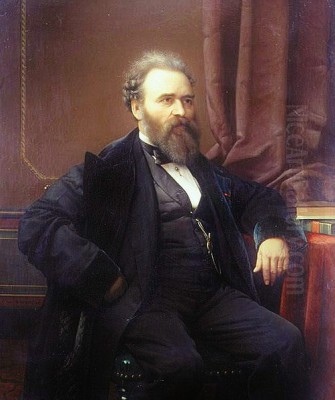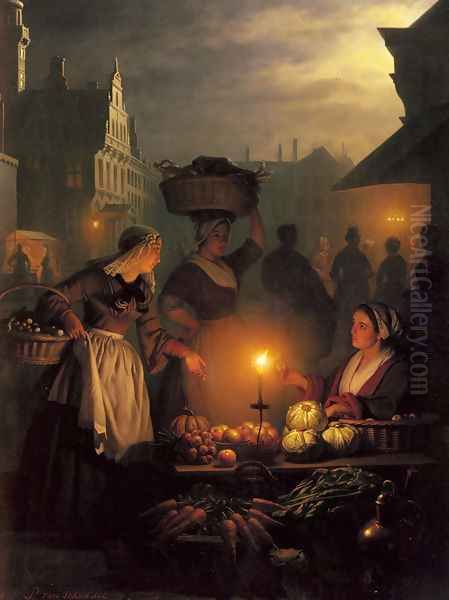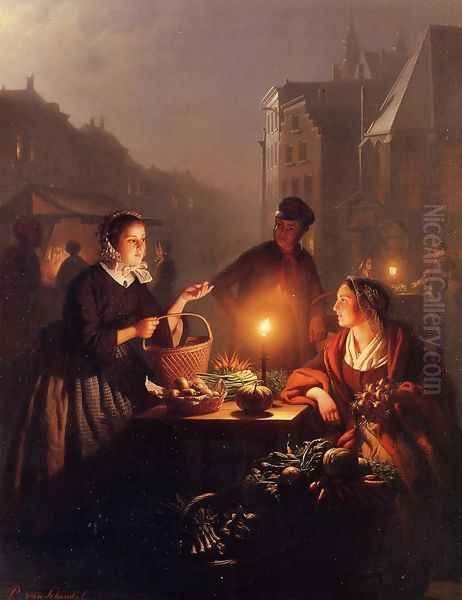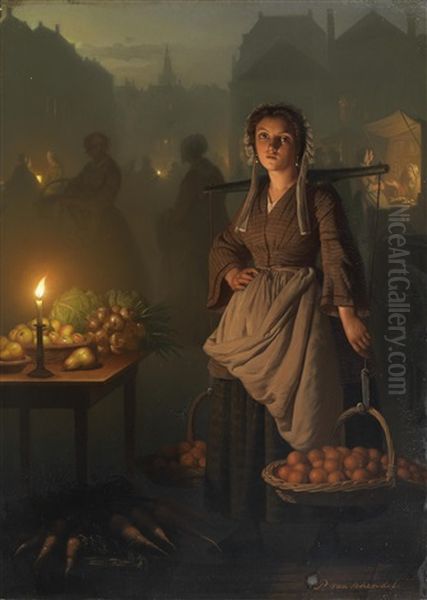
Petrus van Schendel stands as a unique figure in 19th-century European art, a Dutch-Belgian painter whose name became synonymous with the evocative depiction of night scenes illuminated by artificial light. Born in Terheide, near Breda in the Netherlands, on April 21, 1806, and passing away in Brussels, Belgium, on December 28, 1870, his career spanned a period of significant artistic transition. He masterfully blended the technical precision inherited from Dutch Golden Age traditions with the atmospheric sensibility of Romanticism, carving a niche that brought him international acclaim and the affectionate nickname "Monsieur Chandelle."
Early Life and Artistic Formation
Van Schendel's journey into the world of art began under favourable circumstances. His father, Dominicus van Schendel, was himself involved in the arts as a painter and engraver, suggesting an environment where creative pursuits were encouraged. This early exposure likely nurtured the young Petrus's burgeoning talent and interest in visual representation.
His formal training commenced at the prestigious Royal Academy of Fine Arts in Antwerp. Between 1822 and 1828, he honed his skills under the tutelage of Mattheus Ignatius van Bree, a respected history painter of the time. Van Bree's instruction would have provided a solid grounding in academic principles, including drawing, composition, and the depiction of historical and allegorical subjects. Van Schendel proved to be a capable student, distinguishing himself by winning an award for "Perspective" upon completing his studies, an early indicator of his aptitude for rendering space and depth accurately.
The Lure of Light: Influences and Inspirations
While his academic training provided a foundation, Van Schendel's distinct artistic identity was profoundly shaped by his deep admiration for the masters of the Dutch Golden Age. He looked particularly to the 17th-century artists renowned for their revolutionary handling of light and shadow. The dramatic chiaroscuro of Rembrandt van Rijn, with its deep shadows and highlighted focal points, undoubtedly left a lasting impression.

Furthermore, the influence of the Utrecht Caravaggisti, particularly Gerard van Honthorst, is palpable in Van Schendel's work. Van Honthorst, often called "Gherardo delle Notti" (Gerard of the Night Scenes) for his mastery of candlelit interiors, pioneered the very type of illumination that would become Van Schendel's hallmark. Van Schendel absorbed these lessons, adapting the intense drama of Baroque chiaroscuro to the more intimate and atmospheric mood favoured by the Romantics. The subtle gradations of light seen in the works of Johannes Vermeer may also have informed his delicate rendering of surfaces and textures under specific lighting conditions.
Crafting a Signature Style: Romanticism Meets Realism
Van Schendel developed a style that skillfully navigated the currents of his time. His work is firmly rooted in the Romantic movement, evident in the evocative moods, the emphasis on atmosphere, and the often sentimental or picturesque quality of his chosen scenes. He sought to capture not just the appearance of a scene, but the feeling it evoked, particularly the quiet mystery and gentle bustle of life after dark.
However, his Romanticism was tempered by a strong undercurrent of realism. His training and inherent skill led him to render figures, objects, and settings with meticulous detail. Fabrics have tangible textures, faces express clear emotions, and the goods displayed in his market stalls are depicted with convincing solidity. This combination of atmospheric effect and detailed observation gives his paintings a unique and enduring appeal. He created worlds that felt both dreamlike and recognizably real.
Master of the Nocturne: Markets by Candlelight and Moonlight
It is for his depictions of night markets and other nocturnal scenes that Petrus van Schendel is most celebrated. He returned to this theme repeatedly throughout his career, exploring the myriad ways artificial light – primarily candlelight and lantern light, but also moonlight – interacted with darkness. These scenes allowed him to showcase his exceptional talent for rendering complex light effects.
In works like the archetypal The Night Market or A Moonlit Vegetable Market, Van Schendel orchestrates a symphony of light sources. The warm glow of candles illuminates faces and wares, casting long shadows and creating pockets of intense brightness against the deep blues and blacks of the night sky or unlit surroundings. Moonlight often adds a cooler, silvery counterpoint, bathing architectural elements or distant figures in a soft radiance.

His skill lay not just in depicting the light sources themselves, but in capturing their effect on different surfaces – the gleam on metal, the translucence of paper lanterns, the soft absorption of light by cloth, the way light models the human form. He understood how light defines shape, creates volume, and directs the viewer's eye. These market scenes, bustling with vendors and customers engaged in quiet commerce, became his signature subject, perfectly suited to his technical abilities and Romantic sensibilities. Market by Candlelight (c. 1865) is another prime example of this enduring fascination.
Beyond the Marketplace: Diverse Subjects
While night markets dominated his output and reputation, Van Schendel's oeuvre encompassed a broader range of subjects. He produced portraits, often characterized by the same sensitivity to light and personality found in his genre scenes. Historical and biblical subjects also featured in his work, particularly earlier in his career, likely reflecting his academic training under Van Bree.
His interior scenes offer a more intimate glimpse into 19th-century life and his own surroundings. A notable example is Interior of the Artist's Kitchen, a painting depicting his own kitchen in Rotterdam. Now housed in the Fondation Custodia in Paris, this work demonstrates his ability to find artistic potential in the everyday, transforming a domestic space through his careful observation of light filtering through windows and reflecting off surfaces. It reveals a personal connection to his subject matter.
Another specific work, Orange Seller by Candlelight, isolates a single figure within the characteristic nocturnal setting, allowing for a focused study of form and expression under the warm glow of a candle. The painting Soirée de feux de Bengale au Vaux-Hall captures the spectacle of a fireworks display in Breda, showcasing his ability to handle more dynamic and fleeting light effects against a dark backdrop.
Technical Mastery: Chiaroscuro and Palette
Van Schendel's technical prowess was central to his success. His mastery of chiaroscuro was refined and adapted from his Baroque predecessors. He used light not just for illumination, but as a primary compositional tool, guiding the viewer's gaze towards the main subjects and creating a sense of depth and spatial recession. The interplay between brightly lit areas and deep shadows generates visual interest and emotional resonance.
His palette often favoured relatively neutral tones – browns, greys, greens, and deep blues – which allowed the warm yellows, oranges, and reds of the artificial light sources to stand out more vividly. This controlled use of colour contributed to the overall harmony and atmospheric unity of his compositions. His brushwork was typically smooth and detailed, allowing for a high degree of finish and realism, particularly in rendering textures and facial features.
Career, Recognition, and Contemporaries

After completing his studies in Antwerp, Van Schendel worked in several Dutch cities, including Amsterdam and Rotterdam, before settling in The Hague for a period. He eventually moved to Brussels in 1845, where he remained until his death. Throughout his career, he actively participated in the art world of the Low Countries, regularly exhibiting his work at the important "Triennial Salons" held in Antwerp, Brussels, and Ghent.
His unique specialization quickly garnered attention and acclaim. His candlelit scenes were popular with the public and critics alike, admired for their technical brilliance and charming subject matter. His reputation extended beyond the borders of Belgium and the Netherlands; he won medals at exhibitions in Paris and London, cementing his international standing.
This success attracted prestigious patronage. King Leopold I of Belgium was among his admirers and collectors. His work also reportedly caught the attention of other notable figures, including Queen Victoria of Great Britain and King William II of the Netherlands, further testament to his widespread appeal.
Van Schendel worked during a vibrant period for art in the Low Countries. Romanticism flourished, often blending with strong realist traditions. He was a contemporary of other significant Dutch and Belgian artists. In the Netherlands, landscape painters like Andreas Schelfhout and Barend Cornelis Koekkoek (and later his relative Willem Koekkoek) achieved great fame, while Johannes Bosboom specialized in church interiors, often exploring light effects in a different context. The Hague School, with artists like Jozef Israëls, would emerge later in Van Schendel's life, shifting towards a more sombre realism.
In Belgium, historical painting was particularly prominent, championed by figures like Gustave Wappers, Nicaise de Keyser, and Hendrik Leys, who often depicted dramatic scenes from national history. While Van Schendel's focus differed, he operated within this broader artistic milieu, contributing his unique vision of nocturnal intimacy and light. Ary Scheffer, a Dutch-born painter highly successful in France, also explored Romantic themes, though often on a grander scale. Van Schendel's distinct focus on artificial light set him apart even within this rich artistic landscape.
Influence and Enduring Legacy
Petrus van Schendel's dedication to the theme of artificial light secured his place in art history. While perhaps not radically innovative in the manner of later movements, he perfected a specific genre with consummate skill and sensitivity. His work represents a fascinating continuation and adaptation of the chiaroscuro tradition inherited from the Dutch Golden Age, filtered through the lens of 19th-century Romanticism.

His influence can be seen in the work of artists who followed, particularly those interested in capturing similar light effects. The Belgian painter Evariste Carpentier, for instance, created works like Jeune fille apprenant à lire à la lueur de la chandelle (Young Girl Learning to Read by Candlelight), which clearly echoes Van Schendel's thematic and technical concerns, suggesting a direct inspiration, even if Carpentier wasn't a formal pupil.
Today, Van Schendel's paintings remain highly sought after by collectors and are held in numerous museums across Europe and North America. Their appeal endures, captivating viewers with their blend of technical virtuosity, atmospheric charm, and intimate glimpses into 19th-century life after dark. He reminds us of the beauty to be found in quiet moments, illuminated by the simple, warm glow of a candle or the cool shimmer of the moon.
Conclusion: The Painter of Gentle Light
Petrus van Schendel carved a distinct and luminous path through 19th-century art. As "Monsieur Chandelle," he became the undisputed master of the candlelit scene, transforming everyday moments – market stalls, domestic interiors, quiet street corners – into captivating studies of light and shadow. Drawing inspiration from the Dutch masters yet infusing his work with the spirit of Romanticism, he created paintings that are both technically brilliant and deeply atmospheric. His meticulous attention to detail, combined with his unparalleled ability to render the subtle nuances of artificial light, ensures his enduring legacy as a painter who truly knew how to illuminate the night. His work continues to enchant, offering a warm glow that transcends time.